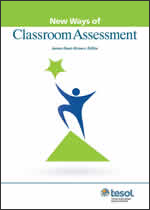|
 This activity comes from New Ways of Classroom Assessment,
Revised, edited by James Dean Brown (TESOL, 2013). Purchase the book in
the TESOL Bookstore, and check out the other books in the New Ways
series. This activity comes from New Ways of Classroom Assessment,
Revised, edited by James Dean Brown (TESOL, 2013). Purchase the book in
the TESOL Bookstore, and check out the other books in the New Ways
series.
|
Levels:
Pre-beginning/preliterate
Aims: Assess
pre-reading skills before starting instruction
Class Time: 20–30
minutes
Preparation: Time 60
minutes
Pre-beginning or preliterate learners present a
unique challenge for assessment. Students may speak a language that uses a
non-Latin alphabet such as Arabic, Chinese, or Japanese. Some learners may
speak a language with no written alphabet, or they may be nonliterate in their
own language. An oral interview can determine speaking proficiency, but how can
literacy readiness be assessed? Student levels of proficiency may range from
none, to some word and letter recognition skills.
Basic literacy is essential to the learning
process. Both reading and writing are active skills that aid language
acquisition and reinforce speaking skills. Preliterate students will vary in
their ability to use and recognize the written word. The following suggestions
will help ESL instructors find a starting point for ESL literacy instruction.
Can the reader see the differences between symbols and recognize the concepts
of same-and-different and left-to-right visual sequencing? Does the reader look
to the number on the left and track to the right?
Procedure
-
Because of the nature of this diagnostics
assessment, it should be done individually, giving instructions orally in
language the student can understand.
-
Give students a copy of the assessment
activities in the Appendix.
-
Walk each student through the tasks.
-
If a student gets 2 of the 4 nonexample items
correct in a task, continue to the next task until the student falls below that
score. Note the last letter the student successfully identified.
-
When the student is finished, thank him, and
tell him when you will provide feedback.
Feedback and
Scoring
-
Each subtest in the sequenced assessment
activities indicates a higher level of pre-reading ability. From symbols, the
test moves on to letters, and then to words. Some students may recognize
familiar words.
-
Use this information diagnostically to form
groups of students or to place students into levels of literacy study as
follows:
- A and B = Beginning
- C and D = Letter recognition
- E and F = Word recognition
- G = Basic word knowledge
Caveats and
Options
-
This test assumes that students have mastered
left–right visual sequencing. If they have not, then the instruction can begin
at the level of left–right orientation. Some students will recognize sight
words, especially if they have lived in an English-speaking country for a
while.
-
Content and background knowledge or content
schemata are an important consideration (Grabe, 1991, p. 381). For example, one
would not use tropical words (e.g., frog, palm) in a program based in Alaska.
Cultural knowledge is another factor that must be considered; pig or pork would
not be good words for an ESOL program with Middle Eastern students. A phone
icon would not work with a learner only familiar with cell phones.
References and Further
Reading
Grabe, W. (1991). Current developments in second
language reading research. TESOL Quarterly, 25(3),
375–406.
Magrath, D. (1988). Teaching non-Latin alphabets
through communication. International Review of Applied Linguistics,
26(3), 244–247.
|